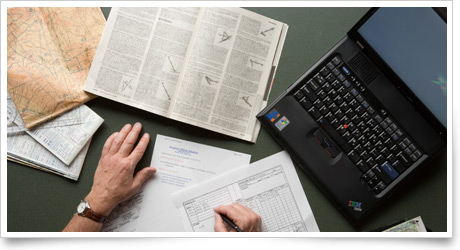| The following stories from the Dec. 23, 2011, edition of AOPA ePilot were provided to AOPA members who expressed an interest in the particular subject areas. Any AOPA member can receive information tailored to their areas of interest by updating their preferences online. |
training tipsDoing the math One such number is your aircraft’s useful load—the weight of the occupants, baggage, usable fuel, and drainable oil. It’s “the basic empty weight subtracted from the maximum allowable gross weight.” Look up the useful load in your aircraft’s weight-and-balance documentation; the information is required to be available in the cockpit. Remember that your useful load data may differ markedly from generic information provided in an off-the-shelf pilot’s operating handbook (POH) for your make and model aircraft. Use only the specifically calculated information for your aircraft! (And if you find yourself wondering just how much weight and balance matters, see the Air Safety Institute’s Essential Aerodynamics course for a practical exercise.) Knowing the useful load at the start of your flight planning can tell you right away whether a particular load is excessive for the flight. Suppose your two-seat Cessna 152 trainer has a useful load of 490 pounds. Full fuel, consisting of 24.5 usable gallons, weighs in at 147 pounds (100 low-lead avgas weighs six pounds a gallon). Now you have just 343 pounds available for people and baggage. Can the two occupants of your aircraft, at their weights—again, not generic weights from the POH—each bring along a well-packed suitcase? Crunch the numbers. If the basic answer is “affirmative,” also check for any baggage-compartment weight restriction. Still good? Go ahead and perform a complete weight-and-balance calculation, including computation of the center of gravity location to ensure that the load will remain within approved limits. What if the answer is negative and the useful load has been exceeded? Now you must plan to lighten the load. That could mean departing with less-than-full fuel, and adding a fuel stop to your planned route. If that’s the decision, give the flight school an early heads-up; many have a policy of keeping their aircraft fuel tanks topped off. Before departure with partial fuel, check carefully for water that may have condensed in the fuel tanks. Safe piloting practices also demand that you assume a high fuel burn as a margin of error in your planning, and that you have an accurate way to measure the partial fuel loads with which you will take off.training productsSporty’s So You Want to Fly Helicopters appIf you’ve been thinking about trying the rotary-wing side of aviation, Sporty’s app, So You Want to Fly Helicopters, is designed to prepare you. The app includes more than 90 minutes of 3-D animations and in-flight video, plus text of the FAA Rotorcraft Flying Handbook, the Helicopter Practical Test Standards, two advisory circulars, and a 30-question review quiz. Fourteen individual video segments show a Robinson R22 and R44, Schweizer 269, and Bell 206 JetRanger. The app sells for $69.99.
Note: Products listed have not been evaluated by ePilot editors unless otherwise noted. AOPA assumes no responsibility for products or services listed or for claims or actions by manufacturers or vendors. final exam
Question: I've heard the term “category” used to describe both airplanes and pilot ratings, and I'm confused about which is correct. Could you give me a definition of “category”?
Answer: Actually, "category" is correctly used in the context of both aircraft and airmen, though with different meanings for each. When referring to airmen certification (FAR 61.5), category means a broad classification of aircraft—for instance, airplane, rotorcraft, glider, lighter-than-air, or powered lift. A pilot could be certified for "airplane single-engine land," with "airplane" being the category of aircraft. When describing aircraft certification, category refers to the way aircraft are grouped, based on operating limitations or intended use. For instance, aircraft are certified in these categories: transport, normal, utility, acrobatic, limited, restricted, or provisional.
Got a question for our technical services staff? E-mail [email protected] or call the Pilot Information Center, 800/872-2672. Don’t forget the online archive of “Final Exam” questions and answers, searchable by keyword or topic. |
 Not all flight planning has to be done hunched over graphs or by punching variables into a flight computer. Memorizing some make-or-break numbers can tell you at a glance whether you can launch on a flight as planned, subject to other considerations.
Not all flight planning has to be done hunched over graphs or by punching variables into a flight computer. Memorizing some make-or-break numbers can tell you at a glance whether you can launch on a flight as planned, subject to other considerations.

